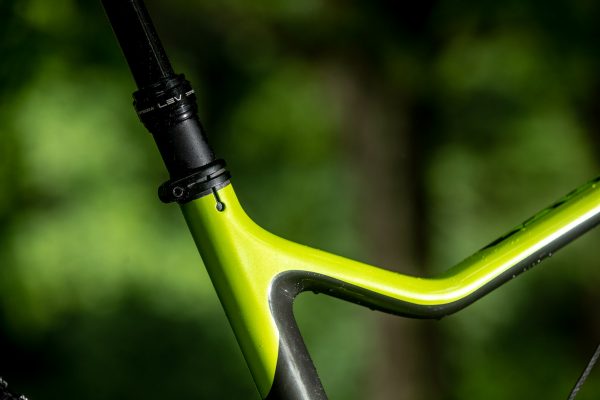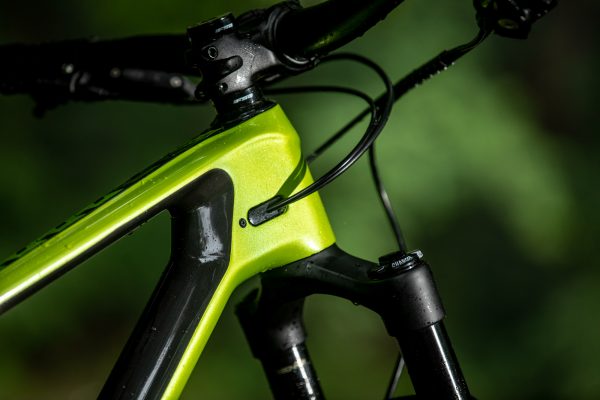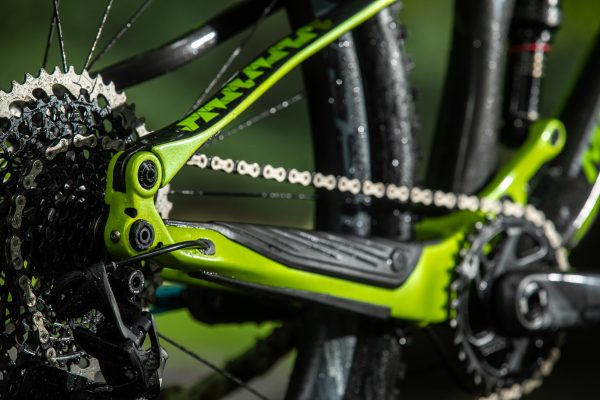Aggressively decked out, big-wheeled trail ripper
Merida now has a posse of models sharing the same gene pool, including the One Sixty and One Forty, the eOne Sixty and this latest One Twenty.
>>> Which Merida mountain bike is right for you?
Merida One Twenty 8000 need to know
- 120mm rear/130mm front 29er trail bike
- Brand new fully carbon fibre chassis (now including all rear stays)
- Perfect parts package for aggro trail riding includes Code disc brakes and 12-speed SRAM GX Eagle
- Tidy hardware detailing and packaging on the Trunnion Mount Metric shock that offers a longer stroke in a shorter body
- Frame: One Twenty UD Carbon Fibre CF4
- Shock: RockShox Deluxe RT3 120mm
- Fork: RockShox Pike RCT3 130mm
- Drivetrain: SRAM XO1 Eagle shifter, mech and cassette, Descendant carbon cranks, GX Eagle chain
- Wheels: FSA Gradient LTD Carbon Boost wheelset, Maxxis Minion DHR II 29 x 2.4” 3C EXO Front, Maxxis Forekaster 29 X 2.35” EXO rear
- Brakes: SRAM Code RSC, 180mm rotors F&R
- Components: Merida Expert TR 760mm bar, Merida 50mm Expert TR stem, RockShox Reverb post w/ Prologo Nago X20 saddle.
- Sizes: S, M, L, XL
- Weight: 12.56kg (27.7lb)
- £TBC

A couple of years back a switch must have flicked at Merida’s German engineering HQ. Before that the brand was better known in cross country circles, but began to prioritise suspension performance over efficiency and weight saving, and a succession of enduro bikes, electric mountain bikes and regular trail bikes started picking up glowing reviews.

To find out what’s behind this apparent change in philosophy, we headed to the Stuttgart R&D office for an exclusive, behind-the-scenes, look and ride on the new bike. It didn’t take long to realise a new, younger generation of designers (and also fanatical bikers) lie behind the brand’s shift in gears. Two key staff are Reynaldo Ilagan and Roman Braig; Head of Product Management and Senior Frame Engineer respectively. Working in a collaborative, open plan environment, the pair sweated over the new One Twenty details for eighteen months, sharing regular test rides and essentially developing the bike they wanted for themselves.

Rey explained, “We’re basically two bike nerds talking about numbers and riding together, but we’ve got the production capability of Merida behind us and freedom to prototype, test ideas and move quickly, so it’s an ideal scenario. The new One Twenty looks similar, but a ton of subtle changes improve everything from frame stiffness, to standover clearance, to hardware.” Roman added, “This new frame builds on everything we’ve already learnt from the Float Link platform, (like) where stresses and load peaks appear, so it’s significantly stiffer and has higher durability than even the 160mm travel model. The main pivot area is bolstered and the tall chainstay is much stiffer laterally, plus the smaller, lighter dropout increases sensitivity. On the Float Link bikes, we prioritise suspension over weight saving, but the carbon frame is still 400g lighter, whereas the aluminium frame is actually around 200g heavier now.”

The One Twenty line up is split between 27.5 and 29in bikes, and also between ‘trail’ and more traditional models with shorter travel forks, longer stems and faster rolling tyres. Rey said, “Merida is a Global brand that has to satisfy a lot of customers, so we still have the weight-weeny versions, but the model you rode uses the parts we choose for ourselves. The Code brakes and Descendant cranks underline the idea of what you can do on this bike and show we’re confident it can handle hard riding.”

For a brand regarded as more traditional, this 29-er 8000 version has a pretty aggressive specification – a stiff, intentionally overbuilt, carbon chassis, Minion DHR II 2.4 WT front tyre, DH-ready SRAM Descendant carbon chainset and 4-piston brakes, wide handlebars, short stem, plus 10mm more front suspension fork travel.

On two rides on flowy, UK-style forest trails in very mixed conditions, I got a good handle on what the One Twenty can do with proper parts bolted on. Like other newer Meridas, the suspension is a highlight with a supportive mid stroke that’s great for pumping speed, resisting blowing through the travel and feeling sporty, without any loss of grip or comfort off the top. The chassis feels really solid and taut too, so you can attack, twist and flick through linked turns and tight trees really precisely.

I’ve ridden and rated most of the 8000’s excellent parts elsewhere, but the new lightweight FSA carbon wheels were impressive, with quick acceleration, plus a dull ride that (with the super-grippy Maxxis tyres) never pinged off edges or felt too knobbly on rough or greasy surfaces.

Overall, the new chassis is more ‘evolution’ than ‘revolution’ with nothing too radical in terms of geometry or quirky features, which helps make it really easy to just get on and ride. By building on its predecessors and really sweating the details, everything is dialled from the off too, so the One Twenty feels solid and surefooted straightaway.
Rey summed up the One Twenty philosophy (something I reckon also mirrors Merida’s new direction), “It’s easiest to be 100% convinced you’re doing the right thing when you do it for yourself, rather than second guessing what a consumer needs. American brands like to shout loudly and claim revolutionary breakthroughs, but that’s not the style of a Taiwanese company designing in Germany. For us, it’s all about attention to detail and continually building on what we’ve learnt already to make the best bike we can.”
The clean-cut, almost minimal One Twenty might not be the most glamorous, nor is it marketed as forcefully as some rivals, but that’s all part of its charm. Understated, practical and packing a serious level of detail, it’s a bike that’ll work for a ton of riding and riders, and one that quietly hammers another nail in acid green Merida’s old reputation of targeting maximum exertion, rather than maximum grin factor.
Focus on: Float Link Suspension
Totally dialled suspension is a priority on all the latest generation Meridas. The Float Link design can manipulate the shock leverage rate at both ends of the damper, and the exact shape of this leverage curve is the focus of the most design, testing and tuning attention. The One Twenty’s main pivot is optimised for a 32T front chainring, and the rocker delivers a lower leverage ratio than the longer travel models, which means the bike can also run on lower air pressures for more sensitivity. This set up also helps heavier riders by not requiring massively high pressures that can interfere with shock performance.
The team went through multiple configurations before settling on the final suspension set up, which uses the lightest compression damping tune available on the RockShox Deluxe shock (and also specific tunes on the cheaper models right down the range.)
Talking in more detail, Rey Ilagan explained, “We’re in the fourth generation of Float Link now, so we really understand how any changes affect the suspension characteristics, and how we can work the best with suppliers and incorporate what’s new coming into the market. We were one of the first to use the Metric shocks, so we’re further down the road with that design than most. The way we’re optimising the One Twenty in terms of priority is leverage ratio first, pedal kickback second and brake jack third. The anti-squat figures with the Float Link are reduced over our previous bikes and by prioritising the attributes in this order we’re aiming for the most neutral ride quality overall, leaning towards a plush, supportive feel on the downhills, rather than pure pedalling efficiency.”




